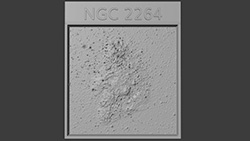CXC Home | Search | Help | Image Use Policy | Latest Images | Privacy | Accessibility | Glossary | Q&A
1
X-ray & Infrared Images of NGC 2264Credit: X-ray: NASA/CXC/SAO; Optical: T.A. Rector (NRAO/AUI/NSF and NOIRLab/NSF/AURA) and B.A. Wolpa (NOIRLab/NSF/AURA); Infrared: NASA/NSF/IPAC/CalTech/Univ. of Massachusetts; Image Processing: NASA/CXC/SAO/L. Frattare & J.Major
 "Blinking Lights" Version
"Blinking Lights" VersionMP4,
Animated GIF
This composite image shows the Christmas Tree Cluster. The blue and white lights (which blink in the animated version of this image) are young stars that give off X-rays detected by NASA’s Chandra X-ray Observatory. Optical data from the National Science Foundation’s WIYN 0.9-meter telescope on Kitt Peak shows gas in the nebula in green, corresponding to the “pine needles” of the tree, and infrared data from the Two Micron All Sky Survey shows foreground and background stars in white. This image has been rotated clockwise by about 160 degrees from the astronomer’s standard of North pointing upward, so that it appears like the top of the tree is toward the top of the image.
2
3D Printable Files: NGC 2264, Christmas Tree Cluster (Composite Image)(3D Print Credit: NASA/CXC/A. Jubett, using software by Tactile Universe/N. Bonne & C. Krawczyk & Blender)
The tactile plate of NGC 2246 features a physical relief map based on the intensity of X-ray, Optical & Infrared data,
depicting a cluster of young stars shaped decidedly like a cosmic Christmas tree! The cluster, known as NGC 2264, is in our Milky Way Galaxy, about 2,500 light-years from Earth. Some of the stars in the cluster are relatively small, and some are relatively large, ranging from one tenth to seven times the mass of our Sun.
In this tactile plate, the cluster’s resemblance to a Christmas tree has been enhanced through feature rotation. Optical data is represented by wispy lines and shapes, which creates the boughs and needles of the tree. X-rays detected by Chandra are presented as dots of light on the tree. Infrared data show foreground and background stars as raised specks against the emptiness of space. The plate has been rotated by about 150 degrees from the astronomer’s standard of North pointing upwards. This puts the peak of the roughly conical tree shape near the top of the plate, though it doesn’t address the slight bare patch in the tree’s branches, at our lower right, which should probably be turned to the corner.
In this tactile plate, the cluster’s resemblance to a Christmas tree has been enhanced through feature rotation. Optical data is represented by wispy lines and shapes, which creates the boughs and needles of the tree. X-rays detected by Chandra are presented as dots of light on the tree. Infrared data show foreground and background stars as raised specks against the emptiness of space. The plate has been rotated by about 150 degrees from the astronomer’s standard of North pointing upwards. This puts the peak of the roughly conical tree shape near the top of the plate, though it doesn’t address the slight bare patch in the tree’s branches, at our lower right, which should probably be turned to the corner.
Return to: Sprightly Stars Illuminate 'Christmas Tree Cluster' (December 19, 2023)







